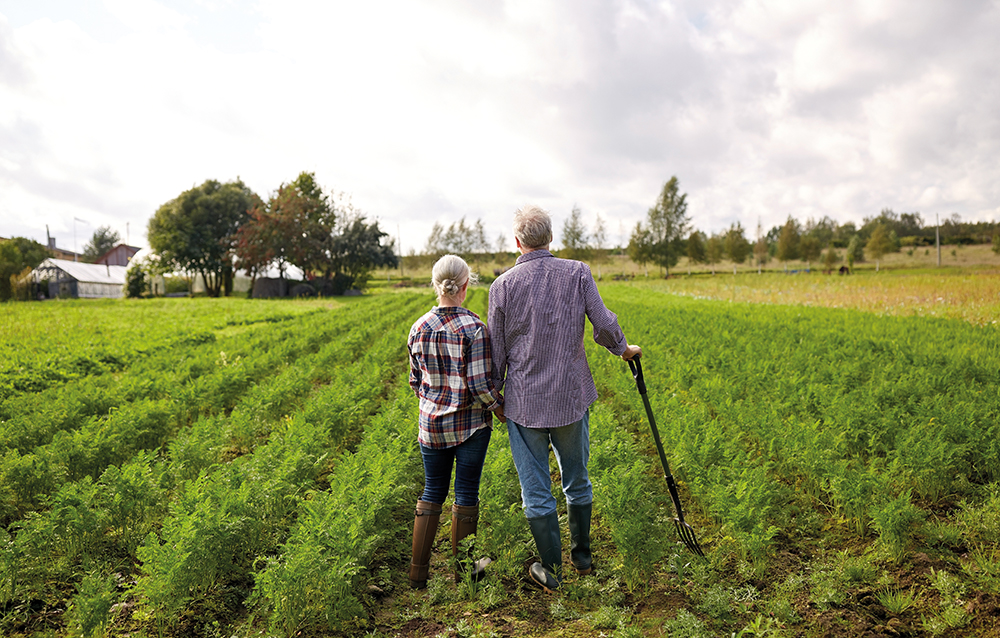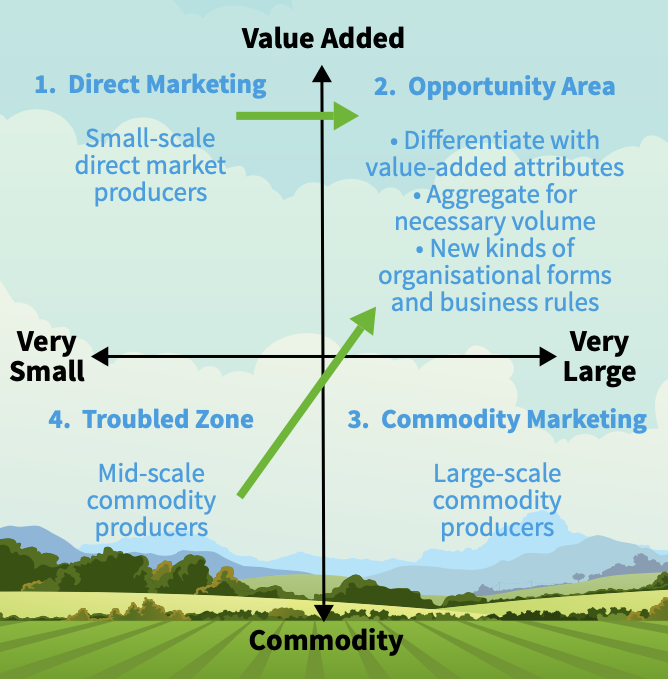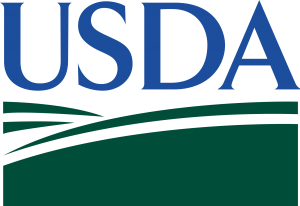Dr Thomas Gray – Cooperative Structures: Finding a Way Forward for Mid-size Farms
More than 80% of agricultural land in the US is managed by farmers whose operations fall between small-scale farms with direct access to local markets, and larger industrialised farms. These farmers in the ‘middle’ increasingly struggle to find a place within the larger food production system. Through his work as part of the ‘Agriculture of the Middle’ Initiative, Dr Thomas Gray of the Rural Business-Cooperative Service at the US Department of Agriculture has been studying different types of cooperative structures for best adaptability to socio-economic and food consumption patterns for mid-size farm survival.
Dilemmas of Survival
Over the last several decades, two parallel agriculture and food systems have emerged from within the larger US agricultural system. These two systems sit at opposite ends of a size continuum and are characterised by very different production types. At the ‘small farm’ end, production is predominantly organic, environmentally sensitive and local, and is sold at farmers’ markets, farm stands and community-supported agriculture markets. Production is diverse and niche, and is often within metropolitan commuting patterns, with annual sales typically peaking at $2500.
Farms at the larger end of the continuum account for huge volumes of commodities marketed at regional, national and global levels through corporate food chains. Unlike the diversified products of the smallest farms, commodity production involves homogeneous, undifferentiated products, with financial gains based on volume rather than niche specialisation. These large farms typically account for annual sales of over $1 million.
In an era when total US farm numbers have decreased dramatically, the numbers of both the smallest and largest farms have increased. Between the two extremes are ‘agriculture of the middle’ (AOTM) farms, sometimes referred to as the ‘disappearing middle’. ‘These farms struggle financially due in part to their specialisation in large volumes of low-value homogenous products, which places them in direct competition with larger, industrialised farms,’ explains Dr Thomas Gray of the Rural Business-Cooperative Service, US Department of Agriculture (USDA). ‘Low returns per unit of product combined with high costs of inputs places large numbers of mid-size farms in a cost-price squeeze. This squeeze is often followed by bankruptcy or acquisition by a neighbouring farm.’
Drs Gray’s recent research investigates the AOTM, and possible cooperative solutions for revitalising mid-size, family-run farms.

Family Farming and Historical Changes
Mid-sized farms tend to be family run. However, the end of the first world war marked the beginning of a progressive industrialisation of production with mechanical advances followed later by chemical, biological and information technology innovations. These developments, along with market competition, pressured family farms to expand production to larger and larger acreages with more intensive production per acre. As scale increased, the more traditional organisation of farming around family ownership, family management and family labour began to come apart. Many family farms ultimately ended up being part of multi-million-dollar operations requiring year-round hired labour and some with hired management.
US Census of Agriculture numbers from 2017 are illustrative of these tendencies: 67% of total agricultural production was accounted for by just 4% of total US farms. These farms were among the largest, all having over one million dollars in sales. However, over 80% of farmland in the US is still managed by farmers whose operations fall between small-scale and large industrialised farms.
Socio-economic and Ecological Trade-offs
The continued thinning-out of family farm structures has not occurred without auxiliary losses involving various other socio-economic and ecological factors. Family incomes, education levels, number of local businesses, and involvement in local organisations all tend to be greater in communities surrounded with a base of small to mid-size farms than in communities in industrialised farm contexts.
Farmers, wholesalers, retailers, universities, governments, NGOs, and community development specialists have sought to protect smaller and AOTM farming, given its several secondary and tertiary socio-economic and ecological benefits.
Agriculture of the Middle Options
Dr Gray’s collaborators, Dr Steve Stevenson and Dr Fred Kirschenmann, have constructed an options grid that illustrates the different choices for US farms (see figure). AOTM farms are depicted in the lower left quadrant and labelled a ‘troubled zone’.
A survival path exists for some producers to acquire and consolidate neighbouring farms, in a process of producing larger volumes of commodities (quadrant 3). This is not a path many mid-scale farmers identify as financially feasible nor personally desirable, and comes with the continued loss of family-structured farming. A few AOTM farms may be able to engage in direct marketing (quadrant 1), and make the necessary shift to organic and relationship marketing. However, this is not feasible for most AOTM farmers, because they are too distant from these markets and have too much volume.
Quadrant 2 may hold the most opportunity for AOTM farms, based on consumer desires for ‘values-dense’ food products that emphasise socio-economic and ecological sustainability. ‘However, making the shift to values-dense, differentiated products would require changes in production. Probable success could be enhanced with brand development, advertising, processing and product moulding, and value-chain development. Most farmers would be unable to afford these functions,’ says Dr Gray. ‘However, all could be performed within the context of an agricultural cooperative.’

Cooperatives: A Possible Solution
Cooperatives are formal social movements, often established in reaction to various social-economic injustices, or market failures. Cooperatives may be the best choice for AOTM development, given they are structured not only as businesses, but also as democracies, and as such, have built-in mechanisms for resolving conflicts of interest among various stakeholders.
As part of the Agriculture of the Middle: Research, Education and Policy group, Dr Gray has been examining cooperative membership structures to determine which form may be most appropriate to help vitalise the mid-size farming category. This work is centred within a project at the USDA’s National Institute of Food and Agriculture and various US Universities (agofthemiddle.org).
‘Our central goal is to create a niche for AOTM farms that could improve their survivability along larger socio-economic and environmental values,’ Dr Gray explains. He cautions, however, that this task is challenging as it involves building business sustainability against massive industrialisation, corporate conglomeration, and evolving technologies.
Local, Centralised or Federated?
Historically, agricultural cooperatives have utilised three predominant organisational structures: local, centralised and federated (though there are other forms). As part of the AOTM Initiative, Dr Gray has assessed each of these, in the context of socio-economic changes in production, cooperative organisational form and consumption, to determine which structure is best positioned to support the survival of mid-size farms.
Local cooperatives are the most bottom-up of the three structures. They may have as few as 10–15 members or as many as 500–1000. Services predominantly involve the joint purchasing of supplies and collective readying and marketing of farm output. Formal democratic control runs from the members as a group to the local organisation, with members electing a board of directors that sets longer run policy for the organisation. Most members live in close proximity to each other and often know each other personally, lending the cooperative a degree of informality unusual in larger organisations.
As open, transparent and democratic organisations, local cooperatives can serve as a vehicle for assembling farmer voices and achieving joint actions – providing farmers with market power and access well beyond what most small to mid-scale farmers could ever achieve as individuals. As independent businesses, with local bases, they represent a dispersed, decentralised approach that can empower farmers to take collective actions to follow sustainability programs. Responsiveness to local agendas almost always occurs by definition in locals, while creativity, commitment and shared identities can evolve out of these actions.
However, as an overall policy approach to national agendas, Dr Gray comments that local co-ops as the sole strategy for mid-size farm survival would likely lack coordination across multiple individual facilities, and nationally. Therefore, they could not easily provide sufficient scale to offset competition from large, well-coordinated, regional and multinational investment-oriented firms.
Similar to local cooperatives, members of a centralised co-op belong to a single organisation. Unlike local co-ops however, memberships often number in the thousands and are typically spread over large geographic regions. Local facilities exist, which provide various services conquerable to those offered in any local cooperative; but dissimilarly, the locals are business branches only, and are not cooperatives themselves. Members elect a board, which is typically mandated to provide strategic planning and board direction for the cooperative.
Centralised co-ops have various advantages of scale, scope and resources that locals do not have. Scale and centralisation allow them to achieve uniformity of products and services regionally, by operating all local units from the centre. Such co-ops have lower operating costs due to centralised control of the handling and marketing of products, greater bargaining power in the marketplace, and a strong ability to adapt to rapidly changing economic conditions.
However, decision making, and operational control are concentrated in the co-op’s headquarters. This means that rather than being characterised by direct participative democracies, like in local co-ops, centralised cooperatives tend to take shape as democratic bureaucracies. This mutes opportunities to develop mutual identities, and members may lose interest in participating in the organisation. An internal logic parallel to return on investment criteria can take precedence, and cooperative operations and member involvement may begin to look similar to investor-oriented firms. Under such situations, achieving the sustainability goals of AOTM farmers becomes more difficult and consumer trust may be lost.

Federations as Both Centralised and Decentralised
Dr Gray’s work leads him to conclude that a combination of local and centralised cooperative models could be the most appropriate solution for pursuing the interests of the middle. This combination is represented by the federated cooperative model, where a collective group is formed from local cooperatives.
In a federation, farmers hold membership in local cooperatives, which in turn, form a cooperative of locals. Locals own the federation and typically provide large proportions of its capital needs. They also elect a board of directors, and this board hires the federation management and provides strategic planning and long-range direction to the larger cooperative.
Like centralised cooperatives, federations are organisationally complex, but this bureaucratic complexity tends to be offset by a direct participative democracy at the local level. Because the federation is built from the bottom-up, local members’ interests may be better expressed, and member contact more readily maintained. Therefore, federations can appropriate various benefits from size and scale, resources for product development and branding, coordination advantages from member-centralisation, and space to compete for a competitive market presence. Member engagement at the local level can produce a sense of community, as well as a reinforced and shared identity.
Considering socio-economic context, history and tensions, federated cooperatives seem a likely choice to accommodate the several agendas of family-close, community embedded, environmentally sensitive mid-size farms. They represent a possible path forward to offset the bleeding out of their current commodity specialisation between the environmentally sensitive direct marketing farms and large commodity producers.
Like all cooperative types, Dr Gray cautions that federations must be chosen and monitored with caution, given their inherent capacity for internal tensions that are intrinsic to any cooperative structure. However, planning for and managing such tensions with the prudent use of member governance structures should help keep the federation aligned with local needs, and the larger consumption demands for socio-economic and ecological products attuned to sustainability concerns. Such strategies could open up greater possibilities for farmers and their cooperatives with positive and widespread benefits for the wider communities of which they are an essential part.
Reference
https://doi.org/10.33548/SCIENTIA536
Meet the researcher

Dr Thomas Gray
Rural Development
United States Department of Agriculture
Washington, DC
USA
Dr Thomas Gray studied for both his master’s degree in Agricultural Economics and his PhD in Rural Sociology at Ohio State University. He also holds a master’s degree in Social Work from the Catholic University of America and has completed psychoanalytic training at the Institute of Contemporary Psychoanalysis in Washington DC. Dr Gray is employed by the USDA, Rural Development, and is affiliated as a ‘Cooperative Scholar’ with the Canadian Centre for the Study of Cooperatives. Dr Gray’s research focuses on cooperatives at three levels of analyses – micro and member participation studies, meso and organisational analyses of governance, and macro on contextual issues such as changes in the structure of agriculture. Most recently, in 2019, he received a travel grant to study governance in Japanese agricultural cooperatives.
CONTACT
E: thomas.gray@usda.gov
W: https://www.rd.usda.gov/programs-services/all-programs/cooperative-programs
KEY COLLABORATORS
Lauren Gwinn, Oregon State University
Kathryn De Master, University of California-Berkely
Fred Buttel, University of Wisconsin
Thomas Lyson, Cornell University
Steve Stevenson, University of Wisconsin
Fred Kirschenmann, Iowa State University
People affiliated with the Agriculture of the Middle Task Force
People affiliated with the Multistate project, NC-1198, ‘Renewing an Agriculture of the Middle’, USDA, National Institute of Food and Agriculture
FUNDING
USDA, Rural Development
USDA, National Institute of Food and Agriculture
FURTHER READING
TW Gray, Historical tensions, institutionalization, and the need for multistakeholder cooperatives, Journal of Agriculture, Food Systems, and Community Development, 2014, 4, 23–28.
TW Gray, Agricultural cooperatives, in PB Thompson, DM Kaplan (eds.), Encyclopedia of Food and Agricultural Ethics, Dordretch, Netherlands: Springer, 2014.
TW Gray, GW Stevenson, Cooperative Structure for the Middle: Mobilizing for power and identity, in TA Lyson, GW Stevenson, R Welsh (eds.) Food and the Mid-level Farm: Renewing an agriculture of the middle. Cambridge: MIT Press, 2008.
TW Gray, Washington DC: USDA, Rural Business-Cooperative Service Research Report, 216, Selecting a Cooperative Membership Structure for the agriculture-of-the-middle Initiative, https://www.rd.usda.gov/sites/default/files/rr216.pdf.
TW Gray, High Modernity, New Agriculture, and Agricultural Cooperatives, Journal of Cooperatives, 2000, 15, 63–73.

Want to republish our articles?
We encourage all formats of sharing and republishing of our articles. Whether you want to host on your website, publication or blog, we welcome this. Find out more
Creative Commons Licence
(CC BY 4.0)
This work is licensed under a Creative Commons Attribution 4.0 International License. 
What does this mean?
Share: You can copy and redistribute the material in any medium or format
Adapt: You can change, and build upon the material for any purpose, even commercially.
Credit: You must give appropriate credit, provide a link to the license, and indicate if changes were made.
More articles you may like
Grandmothers: Innovation Through Tradition
Grandmother Project – Change through Culture (GMP) is an organisation dedicated to documenting the role of grandmothers and demonstrating the effectiveness of grandmother-inclusive strategies in improving the health and well-being of women, children, and adolescents. GMP’s groundbreaking work challenges conventional wisdom to transform community-based interventions in Africa and beyond, harnessing a powerful but often overlooked resource: the wisdom and influence of grandmothers.
Dr Robert Larkin | Cultivating Change to Improve Soil Health and Increase Potato Yield
Environmental quality and food production are facing the pressing challenges of climate change and global population growth. Dr Robert Larkin from the United States Department of Agriculture-Agricultural Research Service (USDA-ARS) and a team of plant scientists developed and tested a range of crop management systems to help overcome these compounding challenges. Their work is improving soil health and increasing the yield of potato crops, contributing to the future food security of nations.
Professor Giorgio Buttazzo | Artificial Intelligence and a Crossroads for Humanity
Where do we stand with artificial intelligence? Might machines take over our jobs? Can machines become conscious? Might we be harmed by robots? What is the future of humanity? Professor Giorgio Buttazzo of Scuola Superiore Sant’Anna is an expert in artificial intelligence and neural networks. In a recent publication, he provides considered insights into some of the most pressing questions surrounding artificial intelligence and humanity.
Dr Ralf Adam | New Technologies Shaping the Future of Oral Hygiene
Understanding the efficiency of various toothbrush technologies is essential for achieving optimal oral health. Dr Ralf Adam, who leads a dedicated team at Procter & Gamble in Germany, is keen to investigate the complexities of these technologies. His team have provided new insights into the best toothbrush types for plaque removal and the maintenance of gum health. By highlighting the importance of informed oral care decisions and ongoing investigations, this vital research works towards ensuring everyone can achieve a brighter, healthier smile.




